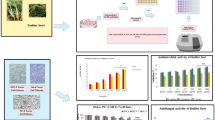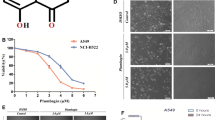Abstract
The present study investigated the cytotoxic and apoptotic effects of an ethanol extract derived from the marine brown alga Dictyopteris undulata against human colon adenocarcinoma cells. The Dictyopteris undulata extract (DUE) showed cytotoxic activity against SW480 cells in a dose-dependent manner, with 50% inhibition of cell viability at a concentration of 40 μg/mL. DUE also induced programmed cell death in SW480 cells, as evidenced by apoptotic body formation, DNA fragmentation, an increase in the population of apoptotic sub-G1 phase cells, and mitochondrial membrane depolarization. Moreover, DUE significantly modulated the expression of apoptosisassociated proteins, resulting in a decrease in B cell lymphoma-2 expression and an increase in Bcl-2-associated X protein expression, as well as the activation of caspase-9 and caspase-3. Furthermore, DUE showed apoptotic cell death in two other colon cancer cell lines, SNU407 and HT29. These observations suggest that DUE may prove useful as a therapeutic agent for the attenuation of colon cancer.
Similar content being viewed by others
Refrerences
Kroemer, G., P. Petit, N. Zamzami, J. L. Vayssiere, and B. Mignotte (1995) The biochemistry of programmed cell death. FASEB. J. 9: 1277–1287.
Bhimani, R. S., W. Troll, D. Grunberger, and K. Frenkel (1993) Inhibition of oxidative stress in HeLa cells by chemopreventive agents. Cancer Res. 53: 4528–4533.
Adams, J. M. and S. Cory (1998) The Bcl-2 protein family: Arbiters of cell survival. Science 281: 1322–1326.
Cohen, G. M. (1997) Caspases: The executioners of apoptosis. Biochem. J. 326: 1–16.
Chen, Y. J., M. S. Shiao, M. L. Hsu, T. H. Tsai, and S. Y. Wang (2001) Effect of caffeic acid phenethyl ester, an antioxidant from propolis, on inducing apoptosis in human leukemic HL-60 cells. J. Agric. Food Chem. 49: 5615–5619.
Halliwell, B. (1984) Oxygen radicals: A commonsense look at their nature and medical importance. Med. Biol. 62: 71–77.
Pereira, H. S., L. R. Leao-Ferreira, N. Moussatche, V. L. Teixeira, D. N. Cavalcanti, L. J. Costa, R. Diaz, and I. C. P. P. Frugulhetti (2004) Antiviral activity of diterpenes isolated from the Brazilian marine alga Dictyota menstrualis against human immunodeficiency virus type 1 (HIV-1). Antiviral Res. 64: 69–76.
Gupta, S. and N. Abu-Ghannam (2011) Bioactive potential and possible health effects of edible brown seaweeds. Trends Food Sci.Technol. 22: 315–326.
Carmichael, J., W. G. DeGraff, A. F. Gazdar, J. D. Minna, and J. B. Mitchell (1987) Evaluation of a tetrazolium-based semiautomated colorimetric assay: Assessment of chemosensitivity testing. Cancer Res. 47: 936–942.
Nicoletti, I., G. Migliorati, M. C. Pagliacci, F. Grignani, and C. Riccardi (1991) A rapid and simple method for measuring thymocyte apoptosis by propidium iodide staining and flow cytometry. J. Immunol. Methods 139: 271–279.
Troiano, L., R. Ferraresi, E. Lugli, E. Nemes, E. Roat, M. Nasi, M. Pinti, and A. Cossarizza (2007) Multiparametric analysis of cells with different mitochondrial membrane potential during apoptosis by polychromatic flow cytometry. Nat. Protoc. 2: 2719–2727.
Green, D. R. and J. C. Reed (1998) Mitochondria and apoptosis. Sci. 281: 1309–1312.
Rosenkranz, A. R., S. Schmaldienst, K. M. Stuhlmeier, W. Chen, W. Knapp, and G. J. Zlabinger (1992) A microplate assay for the detection of oxidative products using 2, 7-dichlorofluorescindiacetate. J. Immunol. Methods 156: 39–45.
Waxman, D. J. and P. S. Schwartz (2003) Harnessing apoptosis for improved anticancer gene therapy. Cancer Res. 63: 8563–8572.
Jemal, A., R. Siegel, J. Xu, and E. Ward (2010) Cancer statistics. CA: Cancer J. Clin. 60: 277–300.
Center, M. M., A. Jemal, R. A. Smith, and E. Ward (2009) Worldwide variations in colorectal cancer. Cancer J. Clin. 59: 366–378.
Haggar, F. A. and R. P. Boushey (2009) Colorectal cancer epidemiology: Incidence, mortality, survival, and risk factors. Clin. Colon Rectal. Surg. 22: 191–197.
Sithranga, B. N. and K. Kathiresan (2010) Anticancer drugs from marine flora: An overview. J. Oncol. 2010: 2141–6.
Mans, D. R. A., A. B. Da Rocha, and G. Schwartsmann (2000) Anti-cancer drug discovery and development in Brazil: Targeted plant collection as a rational strategy to acquire candidate anticancer compounds. Oncol. 5: 185–198.
Yoshie, Y., W. Wang, Y. P. Hsieh, and T. Suzuki (2002) Compositional difference of phenolic compounds between two seaweeds, Halimeda spp. J. Tokyo Univ. Fish. 88: 21–24.
Furusawa, E. and S. Furusawa (1985) Anticancer activity of a natural product, viva-natural, extracted from Undaria pinnantifida on intraperitoneally implanted Lewis lung carcinoma. Oncol. 42: 364–369.
Shan, B. E., Y. Yoshida, E. Kuroda, and U. Yamashita (1999) Immunomodulating activity of seaweed extract on human lymphocytes in vitro. Int. J. Immunopharmacol. 21: 59–70.
Zhuang, C., H. Itoh, T. Mizuno, and H. Ito (1995) Antitumor active fucoidan from the brown seaweed, Umitoranoo (Sargassum thunbergii). Biosci. Biotechnol. Biochem. 59: 563–567.
Coombe, D. R., C. R. Parish, I. A. Ramshaw, and J. M. Snowden (1987) Analysis of the inhibition of tumour metastasis by sulphated polysaccharides. Int. J. Cancer 39: 82–88.
Vischer, P. and E. Buddecke (1991) Different action of heparin and fucoidan on arterial smooth muscle cell proliferation and thrombospondin and fibronectin metabolism. Eur. J. Cell Biol. 56: 407–414.
Religa, P., M. Kazi, J. Thyberg, Z. Gaciong, J. Swedenborg, and U. Hedin (2000) Fucoidan inhibits smooth muscle cell proliferation and reduces mitogen-activated protein kinase activity. Eur. J. Vasc. Endovasc. Surg. 20: 419–426.
Koopman, G., C. P. Reutelingsperger, G. A. Kuijten, R. M. Keehnen, S. T. Pals, and M. H. Van Oers (1994) Annexin V for flow cytometric detection of phosphatidylserine expression on B cells undergoing apoptosis. Blood 84: 1415–1420.
Hengartner, M. O. (2000) The biochemistry of apoptosis. Nature 407: 770–776.
Kim, E. Y. and A. K. Kim (2012) Apigenin sensitizes Huh-7 human hepatocellular carcinoma cells to TRAIL-induced apoptosis. Biomol. Ther. 20: 62–67.
Costantini, P., E. Jacotot, D. Decaudin, and G. Kroemer (2000) Mitochondrion as a novel target of anticancer chemotherapy. J. Natl. Cancer Inst. 92: 1042–1053.
Debatin, K. M., D. Poncet, and G. Kroemer (2002) Chemotherapy: Targeting the mitochondrial cell death pathway. Oncogene 21: 8786–8803.
Deveraux, Q. L. (1999) IAP family proteins-suppressors of apoptosis. Genes Dev. 13: 239–252.
Park, C., D. O. Moon, C. H. Rhu, B. T. Choi, W. H. Lee, G. Y. Kim, and Y. H. Choi (2007) β-Sitosterol induces anti-proliferation and apoptosis in human leukemic U937 cells through activation of caspase-3 and induction of Bax/Bcl-2 ratio. Biol. Pharm. Bull. 30: 1317–1323.
Oh, K. J., S. Barbuto, K. Pitter, J. Morash, L. D. Walensky, and S. J. Korsmeyer (2006) A membrane-targeted BID BCL-2 homology 3 peptide is sufficient for high potency activation of BAX in vitro. J. Biol. Chem. 281: 36999–37008.
Paris, C., J. Bertoglio, and J. Breard (2007) Lysosomal and mitochondrial pathways in miltefosine-induced apoptosis in U937 cells. Apoptosis 12: 1257–1267.
Author information
Authors and Affiliations
Corresponding authors
Rights and permissions
About this article
Cite this article
Kim, A.D., Kang, K.A., Piao, M.J. et al. Dictyopteris undulata extract induces apoptosis in human colon cancer cells. Biotechnol Bioproc E 19, 419–425 (2014). https://doi.org/10.1007/s12257-014-0200-8
Received:
Accepted:
Published:
Issue Date:
DOI: https://doi.org/10.1007/s12257-014-0200-8




